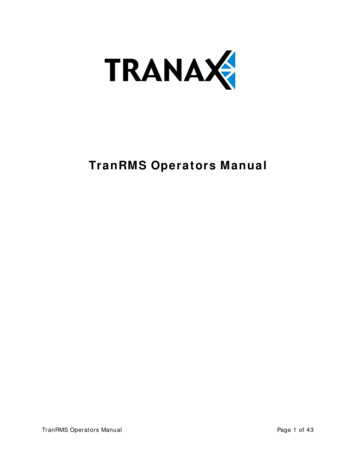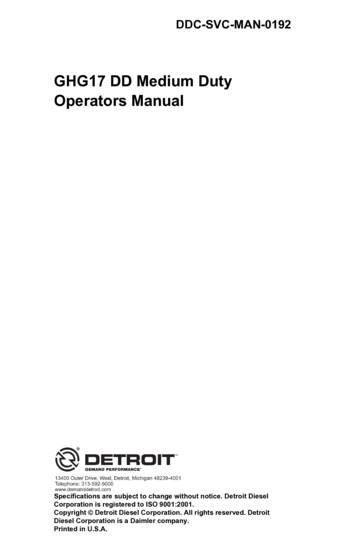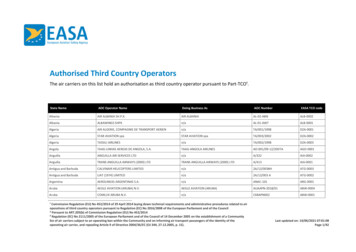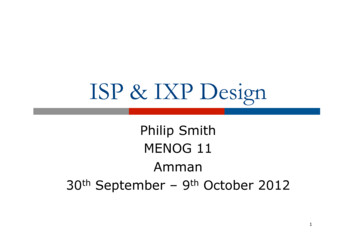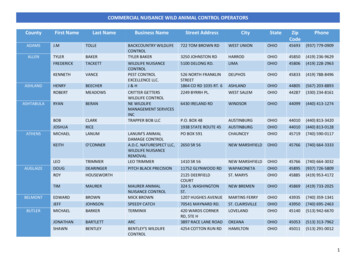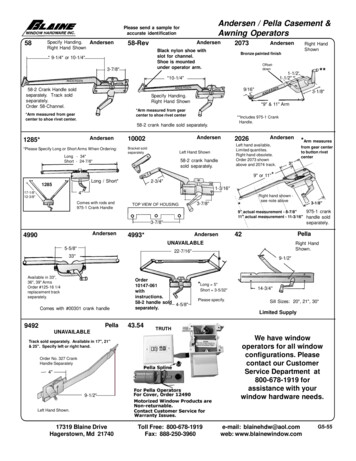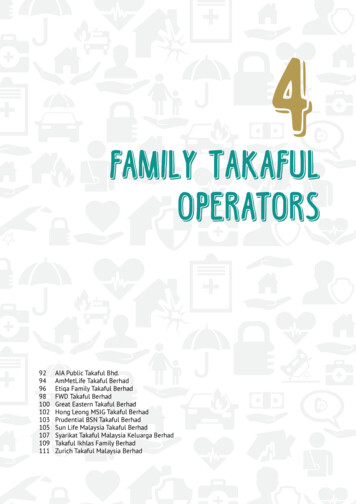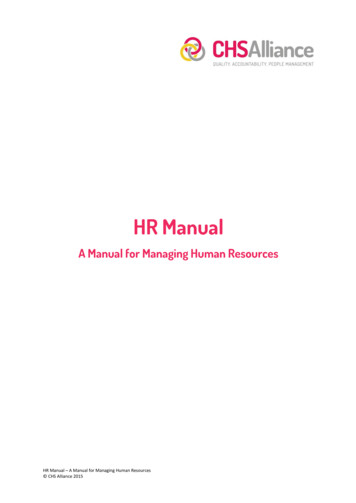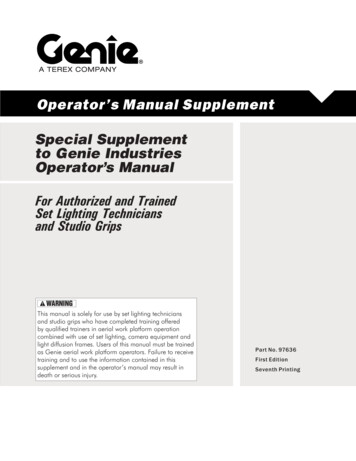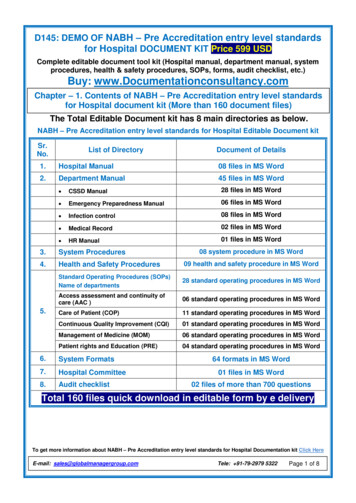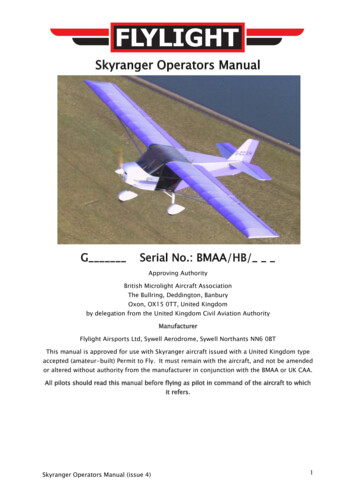
Transcription
Skyranger Operators ManualGSerial No.: BMAA/HB/Approving AuthorityBritish Microlight Aircraft AssociationThe Bullring, Deddington, BanburyOxon, OX15 0TT, United Kingdomby delegation from the United Kingdom Civil Aviation AuthorityManufacturerFlylight Airsports Ltd, Sywell Aerodrome, Sywell Northants NN6 0BTThis manual is approved for use with Skyranger aircraft issued with a United Kingdom typeaccepted (amateur-built) Permit to Fly. It must remain with the aircraft, and not be amendedor altered without authority from the manufacturer in conjunction with the BMAA or UK CAA.All pilots should read this manual before flying as pilot in command of the aircraft to whichit refers.Skyranger Operators Manual (issue 4)1
Skyranger Operators Manual (issue 4)2
Contents1.Introduction . 52.Description of the Aircraft . 63.Limitations . 84.Flying the Skyranger . 105.Performance . 216.Emergencies . 237.Rigging and De-rigging . 258.Weight and Balance . 269.Maintenance . 279.7 Check A . 309.8 Routine maintenance worksheet . 3210.Repairs . 4011. Trim and tuning . 4212. Vital Statistics . 44Annex AThe BMAA Airworthiness Approval Note recommending issue of apermit to flyAnnex BEngine ManualAnnex CWeight and balance report for this aircraft (form BMAA/AW/028).Annex DMinor modifications fitted to this aircraft (MinMods)Annex EMajor modifications fitted to this aircraft (MAANs)Annex FInstructions and Manuals for other devices fitted to this aircraftSkyranger Operators Manual (issue 4)3
TABLE OF AMENDMENTSReferenceChanges incorporateddateIssue 3Revision of maintenance requirements04.10.18and worksheet. Addition of trim andtuning section. Description of fuelsystem, many other small corrections /changes.Skyranger Operators Manual (issue 4)4
1.Introduction1.1The Skyranger is a three-axis aeroplane, it was certified in the UnitedKingdom to the requirements of British Civil AirworthinessRequirements (BCAR) Section S.1.2This manual is not intended to teach you to fly the aircraft, or to buildit. Learning to fly should be accomplished under the supervision of aflying instructor experienced on the type. A separate build manualexists to instruct you in building the Skyranger from a kit.1.3What this manual will do, is provide the information which a qualifiedpilot requires to safely fly this aircraft (although a conversion by aninstructor, CRI, Coach, familiar with the type is stronglyrecommended), and to carry out routine maintenance and minorrepairs. Manuals exist for this aircraft for use overseas which alsoinclude guidance on fitting modifications. All modifications to a BritishSkyranger must be approved by the British Microlight AircraftAssociation.1.4The license required to fly the Skyranger in the UK are either a EASAPPL / LAPL, UK PPL (A) with SEP or Microlight ratings, UK NPPL withmicrolight rating or NPPL SSEA with differences training for microlightaircraft. Pilots with licenses and experience confined to heavier GAaircraft must carry out differences training to fly the Skyranger. Pilotswith microlight ratings trained for Flexwing aircraft should carry outdifferences training for 3 Axis control systems before attempting to flythe Skyranger.1.5This aircraft must be operated using airframe and engine log books.Entries must be made in the logbooks in ink and within 7 days.Skyranger Operators Manual (issue 4)5
2.Description of the Aircraft2.1AncestryThe Skyranger was conceived by Philippe Prevot in 1991. The first 200examples were manufactured under licence by Synairgie between 1994and 1998. The manufacture of the Skyranger was moved to Aeros inthe Ukraine in 1998, incorporating many developments in the design.The Skyranger was then certified to BCARS in 2001, during which manysmall changes were made. In 2003 there was further facelift of cowlingdesign and tail shape. The design continued to evolve with theintroduction of Swift and Nynja versions. Many of the features of whichcan be incorporated in the Skyranger.2.2ConstructionThe Skyranger is predominately constructed of pin-jointed straightaluminium tubes with wings and tail covered with pre-sewn polyesteror optional laminate fabric. The fuselage is covered in non structuralglassfibre panels.2.3Flying Controls2.3.1 Pitch control is by fore-aft movement of the control stick, withmovement transmitted to a conventional elevator through cables.2.3.2 Pitch trimming is by a hand-operated lever mounted in the centralconsole between the seats, with movement transmitted through a cableto a trim-tab on the starboard elevator, reacted with springs.2.3.3 Roll control is by sideward movement of the control stick, withmovement transmitted through cables to part-span, differentialmovement ailerons.2.3.4 Yaw control is by dual-control foot pedals, with movement to therudder transmitted through cables.2.3.5 Braking is by hand lever operated hydraulic disc brakes.2.3.6 The undercarriage is of tricycle arrangement, with nose wheel steeringmechanically linked to the dual-control rudder pedals.2.3.7 Flaps are lowered in two stages by lifting a hand-operated leverlocated between the seats whilst gripping an integral latching lever.Skyranger Operators Manual (issue 4)6
2.4Fuel system2.4.1 The standard fuel system consists of two polyethelene tanks linkedtogether with a balance pipe. As such they work as one single tank forfuel management purposes.2.4.2 Fuel is drawn from a single outlet through a single fuel tap whichisolates all supply.2.4.3 Fuel is pumped by an engine driven mechanical fuel pump, and an(optional) electrical back-up fuel pump. An anti vapour-lock restrictedreturn allows fuel flow back from the engine compartment to the fueltanks.2.4.4 The tank outlet has a strainer, and an additional fuel filter is used inthe supply line.Skyranger Operators Manual (issue 4)7
3.Limitations3.1IntroductionThis section includes the basic operating limitations for the Skyranger.The full limitations are contained in Homebuilt Aircraft Data Sheet(HADS) HM4, which is used by the Inspector at Annual Permit renewalto ensure, amongst other things, that the correct limitations areplacarded in the cockpit.3.2UnitsWhen noting limitations, it is important to ensure that the limitationswhich you are using use the same units and calibrations as theinstruments in the cockpit. The limitations shown below use knotsCAS (Calibrated Airspeed); your aircraft may have an instrument inmph, and in any case will read IAS (Indicated Airspeed). The differencebetween IAS and CAS is basically the accuracy of your Pitot-staticsystem. The IAS limits for your aircraft were determined when theaircraft was test flown, and are shown in Annex A to this manual.There will also be a placard in the cockpit, however space is allowedbelow for you to insert the IAS limitations and calibration details foryour aircraft.IAS Calibration Card for Skyranger G- .Kn icated)Unless all errors are less than 2 knots, a copy of this calibration card must bedisplayed in the cockpit near to the ASI.Skyranger Operators Manual (issue 4)8
3.3Operational Limitations3.3.1 The Skyranger must only be flown in day VMC conditions3.3.2 The Skyranger is certified to a "permit to fly" standard. This prohibitscommercial operation.3.3.3 UK Skyrangers are approved to a UK standard, this means thatpermission is required from the host country to fly it overseas.However a reciprocal agreement for homebuilt aircraft means that nopermission is required for flights to other ECAC (European CivilAviation Conference) member states.3.3.4 The minimum instrumentation required will depend on the enginefitted. Details for each is specified in the type Homebuilt Aircraft DataSheet (HADS) HM4. Latest issues of which are available on the BMAAwebsite.3.3.5 It is recommended that the Skyranger is not flown where a crosswindcomponent above 15 knots is predicted.3.3.6 Do not fly above 10,000ft standard pressure altitude without the use ofpersonal oxygen.3.3.7 Do not fly if any ice is present on the airframe. Performance, stabilityand handling will all be degraded with dangerous consequences. Donot fly the aircraft into known icing conditions.3.4Flight Limitations and key performance speedsSkyrangerNever exceed speed,Vne108 kn CAS [IAS]Manoeuvring speed,Va72 kn CAS [IAS]Flap limiting speed,Vfe66 kn CAS [IAS]Door open limit speed72 kn CAS [IAS]Speed for best rate of climb Vy53kn CAS[IAS]Speed for best climb angle Vx45 kn CAS [IAS]3.4.2 Maximum Bank angles are 60 either way.3.4.3 Maximum Pitch attitudes are 450 nose up and down from thehorizontal.Skyranger Operators Manual (issue 4)9
3.4.4 Normal acceleration limits are 4g / -2g.3.4.5 At least 55kg (121lb / 8 stone 9lb) must be in the cockpit for flight, nomore than 120kg (264lb / 18stone 12lb) may be carried in each seat.3.4.6 Maximum Take-off weight: 450kg – or 472.5Kg if fitted with anairframe mounted total recovery parachute system.3.4.7 Aerobatics and deliberate spinning are prohibited.3.5Engine LimitationsThe limitations for the engine are contained in Annex B, they are alsoplacarded in the cockpit.4.Flying the Skyranger4.1Pre-Flight InspectionPre flight inspection – Check A, is detailed in the maintenance section.4.2Starting4.2.1 Before starting the engine ensure that the max takeoff weight will notbe exceeded (from fuel/weight placard).4.2.2 The BMAA standard manual pre-start checks [STAIP] are recommended.The actual starting procedures for a particular engine are contained inAnnex B to this manual. The STAIP checks are :Securityaircraft, crew, equipment, secure, brakes ON.Throttlesfull and free, and closed, choke set as required.Areaall around and behind aircraft clear.Ignitionmags ON.PropShout ‘clear prop’, pause then start the engine.Once the engine is running set the recommended warm up RPM andslowly remove the choke.4.3Taxiing4.3.1 Before Taxiing ensure that the engine has run for at least 2 minutesfrom cold. Do not use high RPM until the engine has reached itsminimum flight operating temps.Skyranger Operators Manual (issue 4)10
4.3.2 Taxy at no more than a brisk walking pace, somewhat less if thesurface is rough. Steering is effected through the rudder pedals whichare linked directly to the nosewheel. The turning circle normally isaround 20 feet in diameter (at the aircraft centreline).4.3.3 Relatively light weight aircraft like the Skyranger can be blown over inwinds over 25knots. It is imperative that when taxiing in strong windsthat the correct control placements are used. When the wind is fromthe forward quarters hold the stick into wind and the elevator neutral.When the wind is from the rear quarters the stick should be positionedaway from the wind and the elevator held down.4.3.4 Taxy checksWhen taxiing check: Brakes functioning Compass moving when aircraft turned Slip ball moving when aircraft turned Engine temps warming, no limits exceededSkyranger Operators Manual (issue 4)11
4.4Pre take-off checks (vital actions)Prior to take-off, it is recommended that the following pre takeoffcheck is used. This check is a derivation of the mnemonic CHIFTWA asused in many BMAA schools.C - Controls Position into wind - Check controls for full and free movement Check visually that the controls are moving in the correct senseH - Harness and Hatches Check harnesses and hatches (doors) are secure, no loose objectsI – Instruments and engine Check flight instruments are set and serviceable Check engine instruments are serviceable, minimum operating temps Check choke is OFF Set 3000 RPM and check each ignition in turn – max RPM drop 150 Check for smooth idle around 1500-1700 RPM Increase power to max brakes will hold for at least 10 seconds Check engine indications normal. Reset RPM to 2000F – Fuel and Flaps Check fuel tap is ON Check contents sufficient for flight Cycle flaps and check symmetrical operation, detent operation Set flap as requiredT - Trim Check trim set for takeoff (mid position)W – Wind (and eventualities) Check wind speed and direction / crosswind component Consider emergency actions – abort point EFATO options etcA – All clear Confirm all clear on approach R/T call if required and line up on runwaySkyranger Operators Manual (issue 4)12
4.54.5.1Normal takeoffFor a non performance takeoff, into wind, flaps can either be left inthe fully up –CR (cruise) position, or with the first stage – TO (takeoff)position.4.5.2When lined up and rolling straight smoothly apply full power. Keepstraig
2.3.2 Pitch trimming is by a hand-operated lever mounted in the central console between the seats, with movement transmitted through a cable to a trim-tab on the starboard elevator, reacted with springs. 2.3.3 Roll control is by sideward movement of the control stick, with movement transmitted through cables to part-span, differential-
